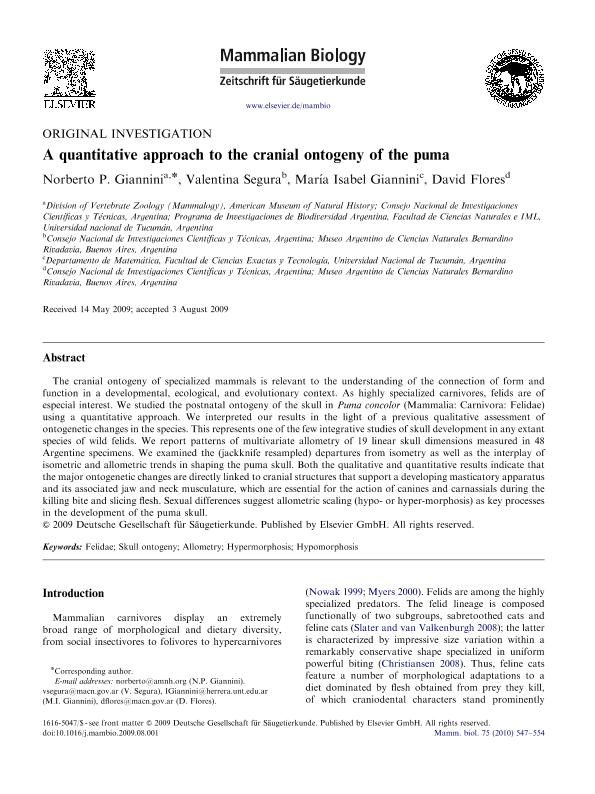Mostrar el registro sencillo del ítem
dc.contributor.author
Giannini, Norberto Pedro

dc.contributor.author
Segura Gago, Alda Valentina

dc.contributor.author
Giannini, María Isabel

dc.contributor.author
Flores, David Alfredo

dc.date.available
2019-01-30T17:53:47Z
dc.date.issued
2010-11
dc.identifier.citation
Giannini, Norberto Pedro; Segura Gago, Alda Valentina; Giannini, María Isabel; Flores, David Alfredo; A quantitative approach to the cranial ontogeny of the puma; Elsevier Gmbh; Mammalian Biology; 75; 6; 11-2010; 547-554
dc.identifier.issn
1616-5047
dc.identifier.uri
http://hdl.handle.net/11336/69020
dc.description.abstract
The cranial ontogeny of specialized mammals is relevant to the understanding of the connection of form and function in a developmental, ecological, and evolutionary context. As highly specialized carnivores, felids are of especial interest. We studied the postnatal ontogeny of the skull in Puma concolor (Mammalia: Carnivora: Felidae) using a quantitative approach. We interpreted our results in the light of a previous qualitative assessment of ontogenetic changes in the species. This represents one of the few integrative studies of skull development in any extant species of wild felids. We report patterns of multivariate allometry of 19 linear skull dimensions measured in 48 Argentine specimens. We examined the (jackknife resampled) departures from isometry as well as the interplay of isometric and allometric trends in shaping the puma skull. Both the qualitative and quantitative results indicate that the major ontogenetic changes are directly linked to cranial structures that support a developing masticatory apparatus and its associated jaw and neck musculature, which are essential for the action of canines and carnassials during the killing bite and slicing flesh. Sexual differences suggest allometric scaling (hypo- or hyper-morphosis) as key processes in the development of the puma skull.
dc.format
application/pdf
dc.language.iso
eng
dc.publisher
Elsevier Gmbh

dc.rights
info:eu-repo/semantics/openAccess
dc.rights.uri
https://creativecommons.org/licenses/by-nc-sa/2.5/ar/
dc.subject
Allometry
dc.subject
Felidae
dc.subject
Hypermorphosis
dc.subject
Hypomorphosis
dc.subject
Skull Ontogeny
dc.subject.classification
Otras Ciencias Biológicas

dc.subject.classification
Ciencias Biológicas

dc.subject.classification
CIENCIAS NATURALES Y EXACTAS

dc.title
A quantitative approach to the cranial ontogeny of the puma
dc.type
info:eu-repo/semantics/article
dc.type
info:ar-repo/semantics/artículo
dc.type
info:eu-repo/semantics/publishedVersion
dc.date.updated
2019-01-30T13:59:51Z
dc.journal.volume
75
dc.journal.number
6
dc.journal.pagination
547-554
dc.journal.pais
Alemania

dc.journal.ciudad
Berlín
dc.description.fil
Fil: Giannini, Norberto Pedro. Consejo Nacional de Investigaciones Científicas y Técnicas. Centro Científico Tecnológico - Tucumán. Unidad Ejecutora Lillo; Argentina. Universidad Nacional de Tucumán. Facultad de Ciencias Naturales e Instituto Miguel Lillo. Programa de Investigación de Biodiversidad Argentina; Argentina. American Museum of Natural History; Estados Unidos
dc.description.fil
Fil: Segura Gago, Alda Valentina. Consejo Nacional de Investigaciones Científicas y Técnicas. Oficina de Coordinación Administrativa Parque Centenario. Museo Argentino de Ciencias Naturales “Bernardino Rivadavia”; Argentina
dc.description.fil
Fil: Giannini, María Isabel. Consejo Nacional de Investigaciones Científicas y Técnicas. Centro Científico Tecnológico Conicet - Tucumán; Argentina. Universidad Nacional de Tucumán. Facultad de Ciencias Exactas y Tecnología; Argentina
dc.description.fil
Fil: Flores, David Alfredo. Consejo Nacional de Investigaciones Científicas y Técnicas. Oficina de Coordinación Administrativa Parque Centenario. Museo Argentino de Ciencias Naturales “Bernardino Rivadavia”; Argentina
dc.journal.title
Mammalian Biology

dc.relation.alternativeid
info:eu-repo/semantics/altIdentifier/doi/http://dx.doi.org/10.1016/j.mambio.2009.08.001
dc.relation.alternativeid
info:eu-repo/semantics/altIdentifier/url/https://www.sciencedirect.com/science/article/pii/S1616504709001268
Archivos asociados
